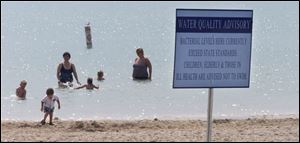
Info line, Web site give beachgoers bacteria updates
6/8/2005
In summers past, some bathers ignore water-quality advisory signs like the one posted at Maumee Bay State Park.
Swimmers now have two ways to get up-to-date information about bacteria trends at 22 public beaches near Ohio's Lake Erie shoreline: A toll-free information line and a Web site.
Both are maintained by the Ohio Department of Health, with assistance from the Ohio Department of Natural Resources and local agencies.
The most recent of the two is the information line, 1-866-OHIO-BCH (1-866-644-6224), which quietly debuted just before last year's swimming season ended on Labor Day.
Kristopher Weiss, state health department spokesman, said it began with little fanfare so the agency could gradually assess public response and tweak it in time for this summer.
Callers get a recorded message explaining that testing is done four times a week between Memorial Day and Labor Day. They can hear about any beaches where advisories have been posted.
A link off the state health department's Web site - www.odh.ohio.gov/ODHPrograms/beach/beachmain.htm - has had data about individual Lake Erie beaches available at the click of a mouse for at least a couple of years.
Click on "Sample Results" at the top of the left column. That will load a map that shows the locations of the 22 beaches.
Click on those for which you want to obtain information.
Be forewarned the data has its limitations, though: Neither mode for obtaining results has same-day figures.
Ohio bases its swimming advisories on a running geometric mean of the five most recent samples, usually drawn by the same people and at the same locations each Monday through Thursday. There's at least a 24-hour turnaround in the lab, so figures for those samples usually aren't posted until 4 p.m. each Tuesday through Friday, Mr. Weiss said.
The time lag can mean inadvertent exposure to bacteria or even a delay in taking down signs when swimming conditions have improved enough to be favorable.
Consider the situation at Maumee Bay State Park's Lake Erie beach: The bacteria level there was measured to be 548 colonies per 100 milliliters on Wednesday, more than four times higher than the baseline threshold of 126 colonies per 100 milliliters.
But because it was only the second day samples were drawn, advisories weren't posted.
The level fell back to 236 and 211 colonies of bacteria per 100 milliliters on Thursday and Monday, respectively. But even with those results, the bacteria level has been unhealthy for three of the four samples taken since Memorial Day.
Mike Oricko, director of environmental health for the Toledo-Lucas County health department, said he wouldn't be surprised if the bacteria level stays high enough there for advisories to be posted soon - especially with the National Weather Service forecasting a chance of thunderstorms today through Sunday, with highs between 85 and 90 degrees.
Storms cause bacteria levels to rise by stirring up sediment. Bacteria also thrive in warmer temperatures.
He said researchers appear to be focused on a ditch flowing through the center of the park as the main culprit. The ditch empties into the lake at the marina, just east of the Lake Erie beach.
Previous problems with the park's inland beach, a few feet away, have been attributed to sea gulls. No problems were identified there from the first four samples.
Port Clinton's city beach had a bacteria problem a few years ago, but hasn't shown a hint of a problem in its first four samples.
East Harbor State Park - the oldest and historically one of the cleanest beaches in Ohio's state park system - also was virtually bacteria-free in its first four samples.
Contact Tom Henry at:
thenry@theblade.com
or 419-724-6079.